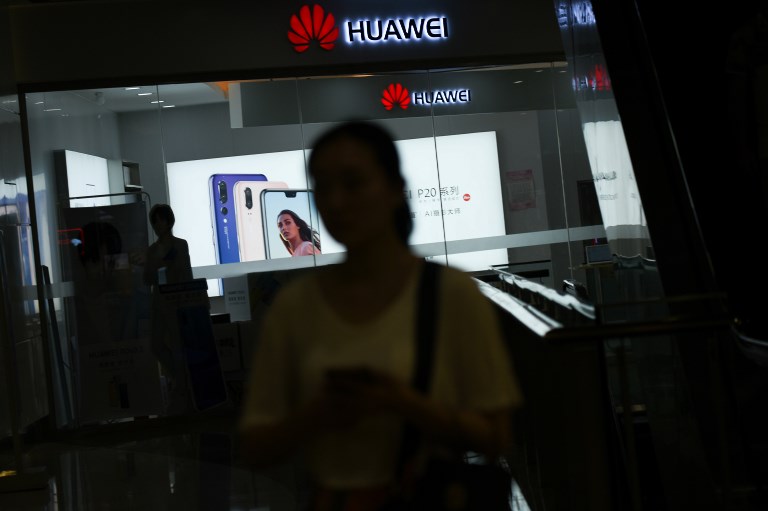

Despite being essentially barred from the critical US market, Huawei surpassed Apple to become the world’s number two smartphone maker in the second quarter of this year and has market leader Samsung in its sights. Huawei has achieved this in part by refocusing away from the futile fight for US access and toward gobbling up market share in developing nations with its moderately priced but increasingly sophisticated phones, analysts said. / AFP PHOTO / WANG Zhao / TO GO WITH China-telecommunication-Huawei-mobile-Samsung-Apple, FOCUS by Dan Martin
by Dan Martin
Agence France-Presse
Ren Zhengfei, the founder of Chinese telecoms behemoth Huawei, likens the company to a ruthless “wolf” tirelessly running down its prey, an ethos that could soon make it the apex predator of the smartphone world.
Despite being essentially barred from the critical US market, Huawei surpassed Apple to become the world’s number two smartphone maker in the second quarter of this year and has market leader Samsung in its sights.
Huawei has achieved this in part by refocusing away from the futile fight for US access and toward gobbling up market share in developing nations with its moderately priced but increasingly sophisticated phones, analysts say.
“Huawei’s image and brand recognition across markets and regions is getting better and better,” said Tarun Pathak of global market analysis firm Counterpoint.
“They’ve differentiated and positioned their products across price segments, which makes an interesting conversation in terms of competing with Apple and Samsung.”
Founded by Ren, now 73, with a few thousand dollars in 1987, Huawei focused initially on the backbone hardware for telecommunications networks, growing to become the world leader.
Fifteen years after introducing its first phone, Huawei surpassed Apple in the April-June quarter to take second place globally, International Data Corporation (IDC) said last week, the first time since 2010 that Apple was not in the top two.
– Raising the ante –
Huawei’s consumer products chief Richard Yu raised the ante Friday, saying the company could overtake South Korean giant Samsung by late 2019.
“The importance of Huawei overtaking Apple this quarter cannot be overstated,” senior analyst Ben Stanton of Canalys wrote in a report on the latest sales data.
“Huawei’s exclusion from the US has forced it to work harder in Asia and Europe to achieve its goals.”
Based in the southern China tech hub of Shenzhen, Huawei had already been pushing into developing markets even before political pressure — peaking this year with President Donald Trump’s China trade war — effectively slammed the US door shut.
Huawei’s exclusion stems in part from US distrust over Ren’s earlier career as a Chinese military technologist and fears that Beijing could strong-arm its tech champions into aiding with espionage abroad. Huawei denies any government links.
In the meantime, Huawei has built up its business in more price-conscious markets, from Indonesia to Saudi Arabia, South Africa and even Europe.
Analysts note that as those markets mature and customers graduate to higher end phones, they will already be in Huawei’s ecosystem.
“If Apple and Samsung want to maintain their market position, they must make their portfolios more competitive,” said Canalys’s Stanton.
Samsung shipped 71.5 million handsets for a 20.9 percent global market share in the second quarter, compared with Huawei’s 54.2 million phones and 15.8 percent share. Apple sold 41.3 million iPhones for a 12.1 percent slice.
Huawei shipped 95 million units in the first half and is targeting 2018 sales of 200 million, a threshold crossed previously only by Samsung and Apple.
Further growth will keep Huawei firmly on the US security radar.
The Trump administration nearly killed Huawei’s Chinese rival ZTE this year, imposing tough penalties for violating US sanctions by selling goods to Iran and North Korea.
– The 5G challenge –
The penalties, since lifted, would have deprived ZTE of US electronics components it desperately needs. Huawei, however, produces its own key components, giving the US less leverage.
But an industry sales slowdown and market saturation could limit its growth.
IDC said 342 million smartphones were shipped worldwide in the second quarter, down 1.8 percent year-on-year and the third consecutive quarterly decline.
In the long term, the lack of a US foothold will be an Achilles heel for Huawei, analysts said, and some market studies project Apple reclaiming the number two spot when new iPhone models are released later this year.
And as Huawei customers graduate to higher end gadgets above $600, the Chinese company will have to compete head-to-head with Apple on quality and features.
“As you move upward, there are fewer competitors but the features, the challenges, the innovation, and the expectations grow,” said Counterpoint’s Pathak.
“That is something that Huawei, Apple and Samsung all need to capitalize on.”
A critical test looms in the next two years, when 5G systems are expected to roll out and manufacturers will be judged on how their smartphones handle the enhanced capabilities.
Huawei is already gearing up for the challenge. Its R&D spending grew 17 percent last year to $13.8 billion, putting the company in the same league as Samsung, Amazon and Google’s parent Alphabet, while recent product launches in Europe have been increasingly glitzy.
“Things like camera capabilities and how Huawei rises overall to that (5G) challenge will decide if it is among the Apples and Samsungs, but I think they belong,” Pathak said.
